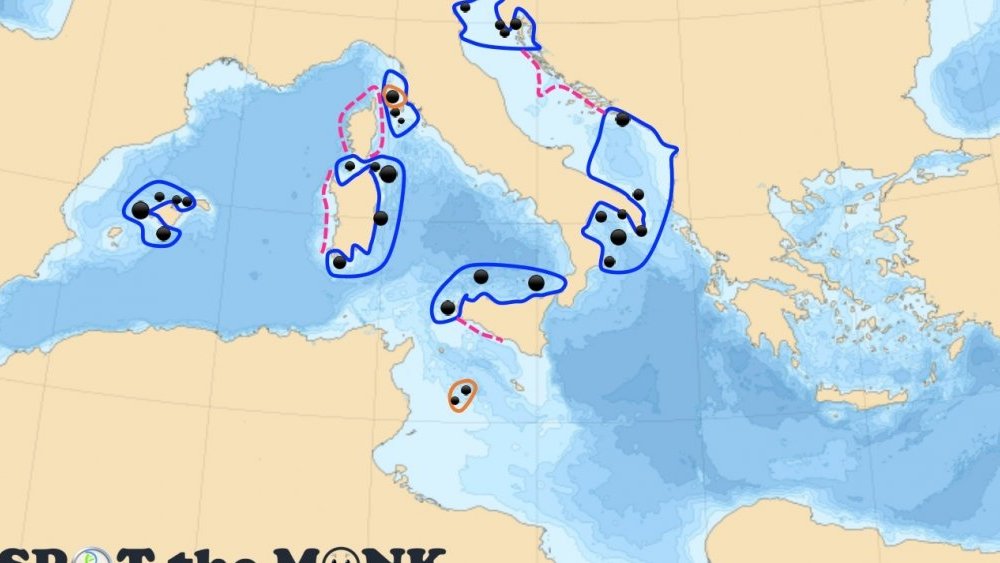The Upper Adriatic between Istria and the Venice Lagoon, Salento-Gulf of Taranto, the smaller Sicilian islands, eastern Sardinia-Caprera Canyon, Tuscan Archipelago, and the Balearic Archipelago. These are the six ‘hot spots’ where monk seals are found, identified by researchers at the University of Milan-Bicocca, through an environmental DNA-based technique, in collaboration with the Gruppo Foca Monaca APS and with the support of nine associations and research organizations involved in sampling operations.
This is revealed in the article “Playing hide and seek with the Mediterranean monk seal”, published in the Scientific Reports journal (DOI: http://doi.org/10.1038/s41598-023-27835-6), which contains data from the extensive monitoring campaign carried out along the Italian coast and in neighbouring stretches of sea between 2020 and 2021 to track the presence of the Mediterranean monk seal (Monachus monachus), one of the world’s rarest species.
Using a revolutionary non-invasive detection system based on the search for environmental DNA in seawater samples, researchers analysed 135 samples taken from 120 locations in the central-western Mediterranean Sea for molecular traces of the monk seal. The analysis revealed the presence of the rare pinniped in areas where there has been a lack of direct observations for decades, such as in many stretches of sea surrounding the Italian Peninsula, from the waters above Caprera Canyon to the northern Adriatic, right up to the Balearic Islands.
The solid blue lines mark out the six hot spots (with a high rate of positive detections) identified in the study, while the fuchsia dashed lines show the stretches of sea that were monitored, but did not yield molecular data indicative of monk seal presence, at least during the Spot the Monk 2021 campaign, to which the newly published article refers. The areas marked in orange (Tuscan and Pelagian archipelagoes) mark the ‘hot spots’ previously identified by the same authors, using the same methodology, and reported in the article in “Biodiversity and Conservation”
The research has provided a new ‘view’ of the monk seal’s territorial distribution, identifying six areas of significant interest (‘hot spots’) where monitoring activities in the coming years will be immediately concentrated. Another relevant finding is the ‘positivity’ of some sites historically known to have the species, as well as areas near small islands and Marine Protected Areas.
The detection method was developed by Elena Valsecchi, a molecular ecologist in the Department of Environmental and Earth Sciences at the University of Milan-Bicocca, lead author of the paper and coordinator of the marine environmental DNA Group (Marine eDna Group) at the Milanese university, which for several years has been promoting the ‘MeD for Med - Marine environmental DNA for the Mediterranean’ project, a marine biodiversity monitoring system based on taking water samples and analysing the environmental DNA they contain.
In 2020, the Milan research group launched the ‘Spot the Monk’ project in collaboration with the Gruppo Foca Monaca for the ‘focused’ study of this pinniped. Emanuele Coppola, president of the Gruppo Foca Monaca APS and co-author of the publication, was responsible for identifying sampling sites in order to estimate the seasonal passage of pinnipeds and the extent of their fidelity to individual areas. Coastal sites which, through direct experience or geo-morphological assessment, were identified as potential habitats of choice for the monk seal.
The ‘Spot the Monk’ 2021 campaign, which led to the identification of the six ‘hot spots’, was also made possible through the involvement of various citizen science programmes from nine associations and research organisations (in alphabetical order: Centro Ricerca Cetacei, Circolo Nautico Rimini, Filicudi Wildlife Conservation, Fondazione Cetacea, IMEDEA (CSIC-UIB), One Ocean Foundation, Progetto Mediterranea, Progetto Manaia and Sailing for Blue Life), which worked to collect the samples, allowing them to be simultaneously gathered in different marine districts, a strategy that allowed better delineation of the pinniped’s presence or absence map.
“It is important that this monitoring is carried out in a consistent and scientifically certified manner,” comment research team leaders Elena Valsecchi and Emanuele Coppola. “This is the only way we will be able to have comparable data that will allow us to follow the much hoped-for return of the species to the central Mediterranean in the coming years. A happy event awaited not only by our country, but also by France, Spain, Morocco and Tunisia.”
This research complements the results, obtained using the same approach, published a year ago by researchers in “Biodiversity and Conservation” (DOI: https://doi.org/10.1007/s10531-022-02382-0). The end goal is to estimate seasonal movements and the use that the species makes of various marine habitats, partly thanks to the integration of other samples collected on the high seas, such as those taken from ferries sailing along trade routes (as described in another article by Elena Valsecchi, published in“Frontiers in Marine Science” , DOI: https://doi.org/10.3389/fmars.2021.704786).
Finally, the collaboration between the University of Milan-Bicocca and the Gruppo Foca Monaca has also seen the involvement of foreign academics: IMEDEA (Instituto Mediterráneo de Estudios Avanzados) based on the island of Majorca, and the University of Edinburgh, which was involved in the most recent monitoring carried out last autumn between the Gulf of Taranto, Salento and the Albanian coasts.
